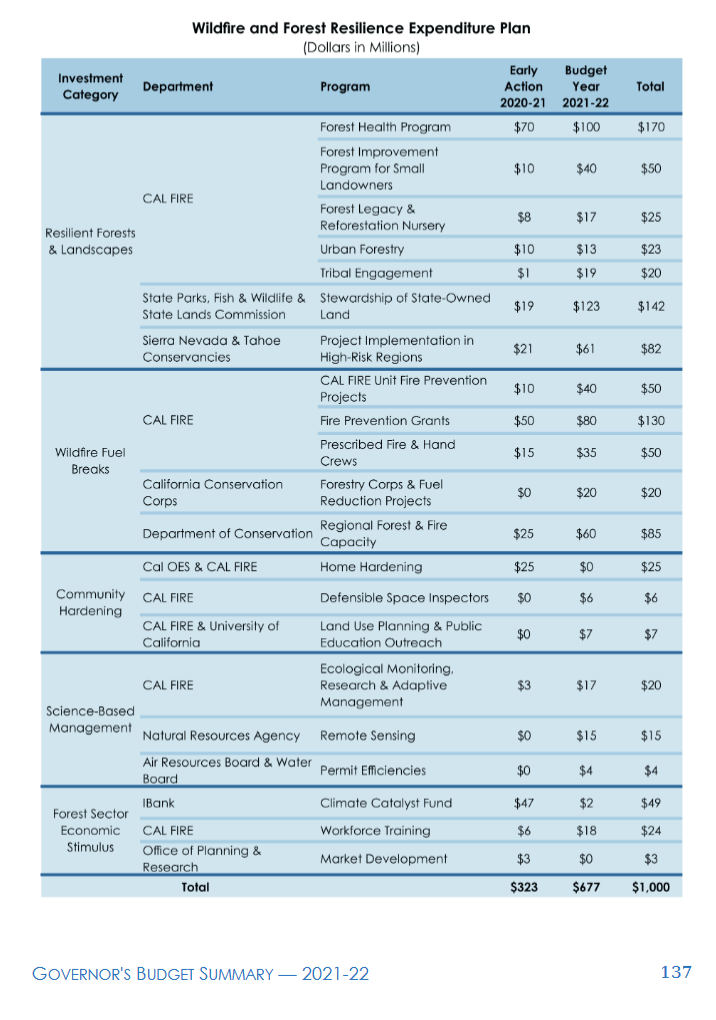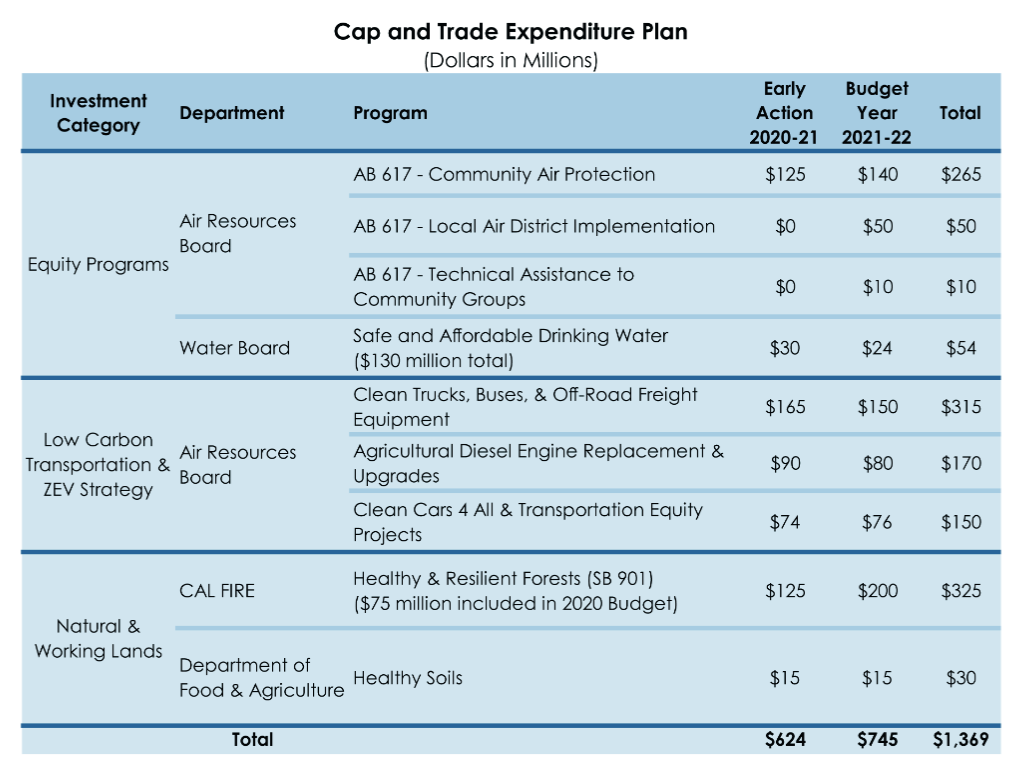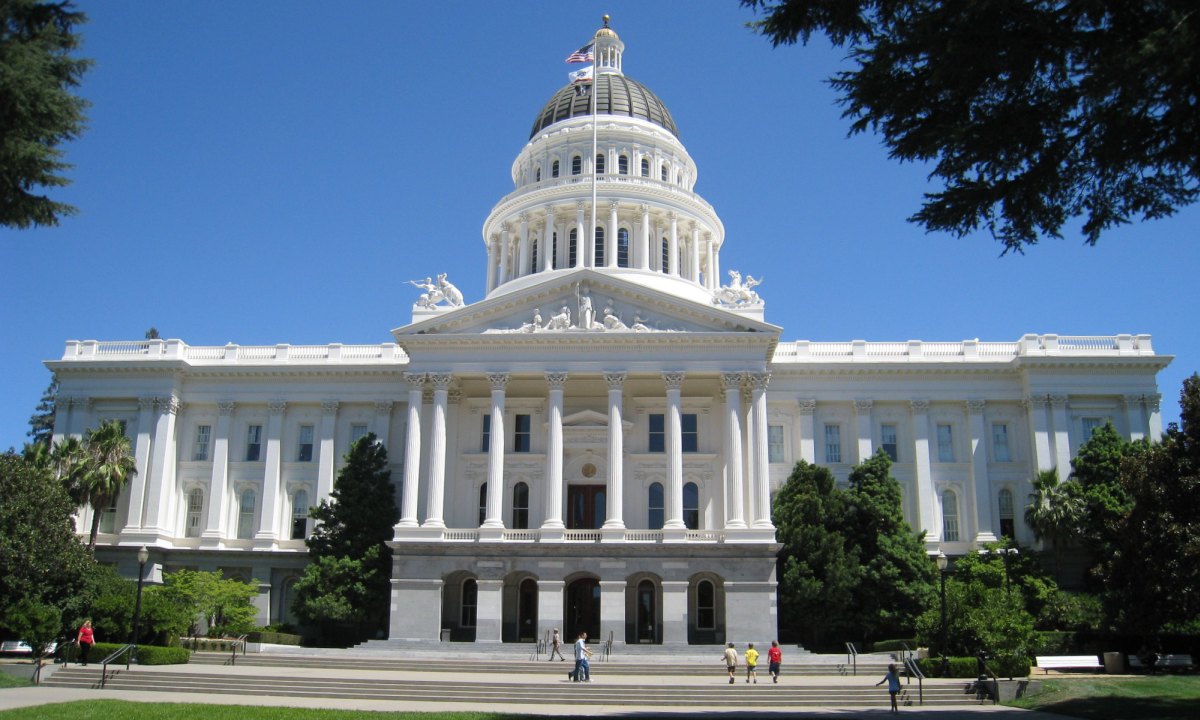Governor Gavin Newsom today submitted his 2021-22 State Budget proposal to the Legislature totaling $227.2 billion. Here are some of the highlights pulled from the climate change, sustainable agriculture, natural resources, and environmental protection chapters. The full budget document is below.
CLIMATE CHANGE
Wildfire and forest resilience
To address the scale and urgency of these wildfire risks, the Budget includes $1 billion to support the Forest Management Task Force’s Wildfire and Forest Resilience Action Plan, including $323 million proposed for early action in 2020-21 to accelerate fire prevention projects that protect communities and other efforts to jumpstart economic recovery in the forest sector.
Here’s the breakdown: 
Natural and Working Lands
The Budget reflects California’s commitment to improving management of natural and working lands to advance the state’s climate change goals of achieving carbon neutrality, expanding carbon sequestration, and building climate resilience across the state’s diverse landscapes.
• Restoration of Natural Areas and Ecosystems—$248.6 million
◦ $125 million one-time Proposition 68 for the Natural Resources Agency to support multi-benefit water quality, water supply and watershed protection and restoration projects.
◦ $79.9 million one-time from various bond funds for the Wildlife Conservation Board to support multi-benefit ecosystem and watershed protection and restoration projects including, but not limited to, the Lower American River Conservancy Program, the Pacific Flyway program, and Wildlife/Fish Passage programs.
◦ $43.7 million in 2021-22, and a total of $69.6 million over five years, from various fund sources for the Department of Water Resources to support restoration projects through the Riverine Stewardship and San Joaquin Restoration programs, ecosystem enhancement projects in the Delta, and a plan to increase watershed resilience in the San Joaquin Basin.
• Flood Management—$183 million
◦ $81 million in 2021-22, and a total of $102.3 million over three years, from various bond funds for the Department of Water Resources Delta Levees System Integrity Program.
◦ $67 million in 2021-22, and a total of $224.9 million over four years, General Fund for the Department of Water Resources to leverage $1.8 billion in federal funding for the flood risk reduction American River Commons Features project.
◦ $28.5 million one-time Proposition 68 for the Department of Water Resources to support collaborative flood risk management.
◦ $6.5 million in 2021-22, and a total of $9.5 million over three years, Proposition 1 for the Department of Water Resources to support emergency flood response in the Delta.
• Coastal Protection—$6.5 million
◦ $6.5 million in 2021-22, and a total of $17.4 million over two years, Proposition 68 for the Natural Resources Agency/Ocean Protection Council to support projects that improve biodiversity and climate resilience by increasing coastal and marine ecosystem health.
Cap and trade expenditure plan
The Budget proposes a $1.37 billion Cap and Trade Expenditure Plan for existing programs, including several early actions for 2020-21. The proposed Expenditure Plan advances the state’s priorities on environmental justice and protects public health by delivering clean air and safe and affordable drinking water. The Expenditure Plan also promotes implementation of the Governor’s recent Climate Executive Orders N-79-20 and N-82-20 on zero-emission vehicles and natural and working lands.
Here’s the breakdown:
 SUSTAINABLE AGRICULTURE
SUSTAINABLE AGRICULTURE
Water efficiency and sustainable groundwater
A significant number of groundwater basins in the Central Valley are critically over-drafted. Agricultural water demand will likely continue to outpace available water supplies into the future. In recognition that the amount of groundwater available for use will be lower than historical pumping levels that have depleted aquifers, the Administration is supporting local communities and the agriculture industry transition to sustainable groundwater use by aligning state investments and policies to enable implementation of the Sustainable Groundwater Management Act. The Budget proposes $100 million one-time General Fund, which includes $50 million as part of the Administration’s proposed early action to support water efficiency projects and a transition to sustainable groundwater.
• Sustainable Groundwater Management Act Grants—$60 million one-time General Fund ($30 million in 2020-21 and $30 million in 2021-22) to the Department of Water Resources for grants to support economic mitigation planning and groundwater implementation projects across critically over-drafted basins.
• State Water Efficiency and Enhancement Program Grants—$40 million one-time General Fund ($20 million in 2020-21 and $20 million in 2021-22) to the Department of Food and Agriculture to provide incentives that help farmers reduce irrigation water use and reduce greenhouse gas emissions from agriculture pumping.
Impact Assessment And Alignment Of Regulatory Reporting Requirements For Agriculture
The agriculture industry is subject to regulatory and reporting requirements across various state agencies. The Budget includes $6 million one-time General Fund for regulatory alignment and efficiencies, including $4 million in 2020-21 to engage a consultant to evaluate and implement the alignment of regulatory reporting activities across state agencies to reduce unnecessary burdens to farmers and ranchers in their efforts to meet regulatory compliance. The Budget also includes $2 million in 2021-22 to support a business assessment to explore the establishment of a unified licensing portal at the Department of Food and Agriculture.
NATURAL RESOURCES
The Department of Water Resources plans for the sustainable management of California’s water resources and helps to implement the Administration’s Water Resilience Portfolio. The Portfolio prioritizes actions to maintain water reliability, protect natural systems, and build regional capacity to adapt to an uncertain climate future.
Implementation of Portfolio actions is well underway, and the Budget continues state investments to advance the Portfolio across the Natural Resources Agency, California Environmental Protection Agency, and Department of Food and Agriculture. These agencies are coordinating closely to prepare for drought and flooding; advance projects of statewide scale and importance; provide resources, tools and standards that support regional leadership; and help coordinate and address challenges that are beyond the scope of any region.
The Budget makes important investments to support local agencies as they work to build regional water resilience, including:
• Sustainable Groundwater—$60 million one-time General Fund ($30 million in 2020-21 and $30 million in 2021-22) for grants to support local planning and implementation of Groundwater Sustainability Plans across critically over-drafted basins. Historic groundwater laws enacted in 2014 require local agencies to bring basins into sustainable conditions within 20 years of implementing their sustainability plans. This additional funding for existing Department grant programs will help local agencies address known data gaps, plan and implement projects, and address deficiencies in initial groundwater sustainability plans. Additional investments in agricultural irrigation efficiency, as referenced in the Climate Change and Sustainable Agriculture Chapters, will also support local agencies as they work to balance groundwater pumping and recharge.
• Flood Preparedness—$183 million in 2021-22, $365.2 million over the next four years, from various fund sources to leverage $1.8 billion in federal funds for the flood risk reduction American River Common Features project, the maintenance and strengthening of levees, the support of emergency flood response activities in the Sacramento-San Joaquin Delta (Delta), and the support of collaborative flood risk management.
• Deferred Maintenance—$75 million one-time General Fund for critical levee repair projects to enhance the state’s resilience to catastrophic flooding.
• Delta Resilience—$43.7 million in 2021-22, $69.6 million over the next five years, from various fund sources to support ecosystem restoration and watershed resilience work on the San Joaquin River and for projects that improve water quality or ecological conditions within the Delta.
Department of Fish and Wildlife
• Wetlands Management—$9.8 million one-time ($9 million General Fund and $800,000 Proposition 12) to modernize the Department’s water conveyance systems into managed wetlands, which will improve habitat, reduce staff maintenance costs, and buffer against climate-driven threats.
• Hatchery Operations—$7 million one-time General Fund to modernize the Department’s hatchery facilities and equipment to provide greater operational reliability and improve fish survival once released into rivers.
• Vegetation Mapping—$5.5 million one-time General Fund to generate a high-resolution vegetation classification map of nearly one million acres of the Northern California coast. The map will provide a baseline for close monitoring of changes to critical ecosystems and species, including the iconic coastal redwoods, estuaries and wetlands, all of which are vulnerable to climate change.
ENVIRONMENTAL PROTECTION
The Governor’s Budget includes $4.3 billion ($460 million General Fund, $3.8 billion special funds, and $16.8 million bond funds) for programs included in this Agency. (Cal EPA)
FOR MORE ON THE PRELIMINARY BUDGET
The PDF is locked so I can’t excerpt the pages for you, but here are the pages and the full summary document:
- Climate change, page 140
- Sustainable Agriculture, page 150
- Natural Resources, page 158
- Environmental protection, page 166



